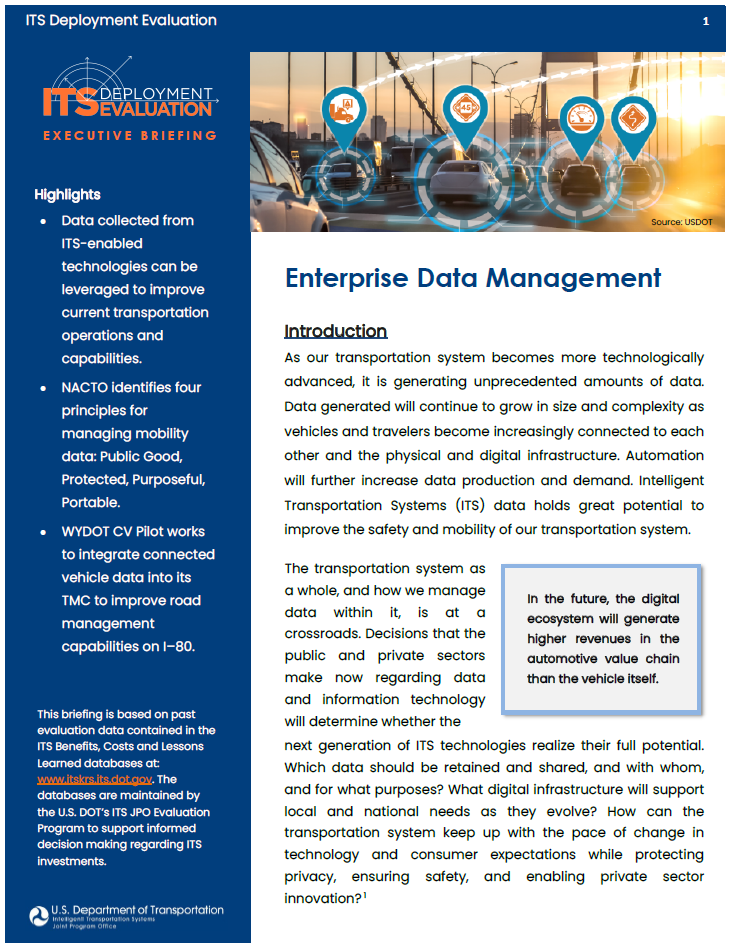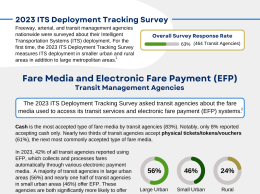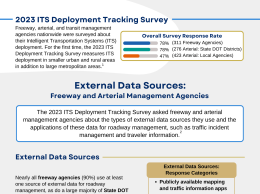2020 Executive Briefing
 BRIEFING HIGHLIGHTS:
BRIEFING HIGHLIGHTS:
- Data collected from ITS-enabled technologies can be leveraged to improve current transportation operations and capabilities.
- NACTO identifies four principles for managing mobility data: Public Good, Protected, Purposeful, Portable.
- WYDOT CV Pilot works to integrate connected vehicle data into its TMC to improve road management capabilities on I–80.
Introduction
As our transportation system becomes more technologically advanced, it is generating unprecedented amounts of data. Data generated will continue to grow in size and complexity as vehicles and travelers become increasingly connected to each other and the physical and digital infrastructure. Automation will further increase data production and demand. Intelligent Transportation Systems (ITS) data holds great potential to improve the safety and mobility of our transportation system.
| In the future, the digital ecosystem will generate higher revenues in the automotive value chain than the vehicle itself. |
The transportation system as a whole, and how we manage data within it, is at a crossroads. Decisions that the public and private sectors make now regarding data and information technology will determine whether the next generation of ITS technologies realize their full potential. Which data should be retained and shared, and with whom, and for what purposes? What digital infrastructure will support local and national needs as they evolve? How can the transportation system keep up with the pace of change in technology and consumer expectations while protecting privacy, ensuring safety, and enabling private sector innovation?1
To support the next generation of ITS technologies, data management technologies and methods should be:1
- Low cost and interoperable to enable regional and national data sharing and integration with other government and third-party data applications.
- Scalable and flexible to adjust for different size deployments and evolving needs.
- Secure to protect and safeguard personal and proprietary data.
- Fast enough to support real-time decision making.
Benefits
Enterprise data have several potential benefits including:2
| USDOT data programs aim to facilitate data access across public and private sectors by providing a common framework to contribute data for multimodal evaluation and analysis. |
- Provide new revenue opportunities. New data sources open the door for innovators to develop applications and methods that can support economic vitality.
- Monitor performance and enable more efficient responses. Increased data from new sources provide a complete, more detailed view of the whole transportation system allowing decision makers to make informed choices on how best to increase system efficiency.
- Increase efficiency of information sharing. Enterprise data will reduce the costs of data management and eliminate technical and institutional barriers to the capture, management, and sharing of data.
- Improve the accuracy and timeliness of data. More refined data collection methods will lead to higher quality data, which in turn will support faster data distribution.
- Stimulate innovation of new research. The increase in data will spark novel development of software and tools to use data in new innovative ways.
Best Practices

The data streams captured by modern mobility service providers contain vital information for proactive planning and policymaking. At the same time, both cities and private companies must take steps to safeguard this data and ensure that individual privacy is protected. Cities and private transportation providers need a common framework for sharing, protecting, and managing this data.
The National Association of City Transportation Officials (NACTO) and the International Municipal Lawyers Association have laid out a framework with principles for city agencies and private sector partners to share, protect, and manage data to meet transportation planning and regulatory goals in a secure and appropriate manner. While the framework focuses mainly on the data generated by ride-hail and shared micromobility services, the data management principles can apply more broadly.3
Principle | Best Practice |
|---|---|
| Data is a Public Good | Cities should obtain data from private vendors operating on city streets to ensure positive safety and mobility outcomes on streets and places in the public right-of-way (2019-00903). |
| Data Should be Protected | Cities and private companies should treat geospatial mobility data as they treat personally identifiable information (PII) (2019-00904). |
| Data Should be Collected Purposefully | Cities should be clear about when, why, and what data is necessary for planning, analysis, oversight, and enforcement purposes (2019- 00905). |
| Data Should be Portable | Open data standards help cities and private companies to share data in universal formats, enabling cities to use data from multiple sources, and supporting innovation in both the public and private sectors (2019-00906). |
Case Study
The Wyoming Department of Transportation (WYDOT) Connected Vehicle (CV) Pilot Deployment Program is intended to develop a suite of applications that utilize vehicle-to-infrastructure (V2I) and vehicle-to-vehicle (V2V) communication technology to reduce the impact of adverse weather on truck travel on the I-80 corridor. Applications being deployed support a flexible range of services from advisories, roadside alerts, parking notifications and dynamic travel guidance.
For the WYDOT CV Pilot deployment, integrating data from connected vehicles into a Transportation Management Center (TMC) was critical. The TMC hosted traffic operations-related data, data management, and communication tools (used to send information to third parties). Functionally, the TMC was the entity in charge of ingesting, processing, archiving, and distributing information related to the day-to-day operation of the roadways managed by WYDOT, making it a natural fit for adding and managing data captured from CVs. WYDOT's experience in developing and integrating data from the CVs into its TMC while considering the security, data management, and operator requirements highlighted the following practices and lessons learned (2019-00854).

Leverage existing open-source software to integrate CV data into a TMC. WYDOT worked in conjunction with software developers to integrate their efforts into the CV pilot project. This saved significant time and yielded a more robust system, one built on top of previous experience.
Software components that were incorporated into this project were the ITS Joint Program Office's (JPO) Operational Data Environment (ODE) and the National Center for Atmospheric Research's Pikalert®. The ODE ingests and processes connected vehicle data from devices—including vehicles, infrastructure, and TMCs—and distributes the information to components of a traffic management system (for example, data warehouses). Pikalert ingests weather data from different sources, including CVs, and generates advisories on current and forecasted road and weather conditions for a variety of users.
Focus on the interfaces. WYDOT's design approach focused on the interfaces the team needed to develop to send, receive, and manage electronic messages or specific CV data. This strategy identified gaps in existing systems and the devices, and the changes needed to the TMC software and hardware platforms to enable the exchange and use of new data. WYDOT was able to determine which ITS applications could remain as-is, which needed to be developed and deployed, and which needed modifications.

Translate CV data into information for the TMC. The CV pilot project produces an estimated 50 million electronic messages per day in addition to the one million already being generated by variable speed limit sensors and road weather information systems. TMC operators simply did not have the capacity to interpret these electronic messages in their entirety given their magnitude and format. WYDOT clearly needed more robust tools and procedures to ingest, process, and analyze CV data to provide actionable data to TMC staff. The WYDOT TMC uses both the ODE and Pikalert systems to translate raw CV data, such as basic safety messages, into discrete, useful information for TMC operators.
Create user-friendly dashboards and tools to monitor performance. Dashboards enable continuous monitoring of the hardware and software components of the CV pilot project. The dashboards serve multiple purposes: they provide visibility of the entire CV pilot infrastructure deployment for TMC operators, deliver important data for performance measurement, and serve as an effective public engagement tool (the public could see the posted messages and how many CVs have passed by the roadside units).
Create a security and data management framework. From the beginning, WYDOT envisioned a project that would follow "secure by design" principles that covered the process of forming, distributing, collecting, using, storing, and discarding data from CVs and TMC systems.
The team examined human and technical aspects of the TMC to ensure they employed proper data management techniques. Every member of WYDOT’s project team and TMC with access to the data was required to pass a background check and successfully complete hours of training on ethical research and protection of personally identifiable information. Access to information was limited to those individuals who needed it for their job functions.
WYDOT employed advanced encryption of databases and in-transit data packets, along with employing firewalls, hardware security modules, and software developed by USDOT to credential authorized vehicles participating in this project. The entire project, from vehicle to the TMC, was evaluated to ensure the latest security techniques were in place.

Re-envision existing systems. WYDOT already had a robust network of data users and data suppliers—with its many traveler information outlets being visited and used by thousands of I–80 users on a daily basis—an efficient data distribution system, and a secure data archiving system. WYDOT assessed each component for improvements to further extend the reach of the CV pilot project. For instance, WYDOT extended its Commercial Vehicle Operator Portal and modified the Transportation Report and Action Console to accommodate Pikalert's advisories and alerts. Similarly, WYDOT upgraded its incident and construction consoles to automate processes, improving its integration and management of CV data.
References
1. Intelligent Transportation Systems (ITS) Data Factsheet. ITS JPO. https://www.its.dot.gov/factsheets/pdf/FactSheet_EnterpriseData.pdf
2. Enterprise Data Whitepaper. ITS JPO. https://www.its.dot.gov/research_areas/pdf/WhitePaper_enterprise.pdf
3. National Association of City Transportation Officials and International Municipal Lawyers Association. “Managing Mobility Data.” NACTO. April 2019. https://nacto.org/wpcontent/uploads/2019/05/NACTO_IMLA_Managing-Mobility-Data.pdf



